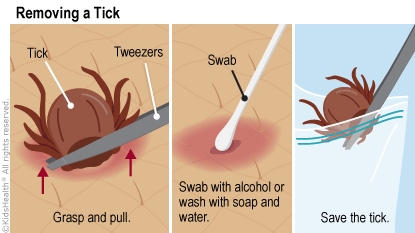- Parents Home
- Para Padres
- A to Z Dictionary
- Allergy Center
- Asthma
- Cancer
- Diabetes
- Diseases & Conditions
- Doctors & Hospitals
- Emotions & Behavior
- First Aid & Safety
- Flu (Influenza)
- Food Allergies
- General Health
- Growth & Development
- Heart Health & Conditions
- Homework Help Center
- Infections
- Newborn Care
- Nutrition & Fitness
- Play & Learn
- Pregnancy Center
- Preventing Premature Birth
- Q&A
- School & Family Life
- Sports Medicine
- Teens Home
- Para Adolescentes
- Asthma
- Be Your Best Self
- Body & Skin Care
- Cancer
- Diabetes
- Diseases & Conditions
- Drugs & Alcohol
- Flu (Influenza)
- Homework Help
- Infections
- Managing Your Weight
- Medical Care 101
- Mental Health
- Nutrition & Fitness
- Q&A
- Safety & First Aid
- School, Jobs, & Friends
- Sexual Health
- Sports Medicine
- Stress & Coping
Tick Removal: A Step-by-Step Guide
You just found a tick on your child! What should you do?
First, don't panic. It's true that Lyme disease is the most common tick-borne disease in the United States. But your child's risk of developing Lyme disease after being bitten by a tick is very low.
To be safe, though, you'll want to remove the tick as soon as possible. The risk of infection rises 24–48 hours after the tick attaches to the skin.
What to Do
Step 1: Use tweezers to grasp the tick firmly at its head or mouth, next to the skin. Use a magnifying glass, if you have one, to see the tick clearly.
Step 2: Pull firmly and steadily until the tick lets go of the skin. Do not twist the tick or rock it from side to side. If part of the tick stays in the skin, don't worry. It will eventually come out on its own.

Step 3: Release the tick into a jar or zip-locked bag.
Step 4: Wash your hands and the site of the bite with soap and water.
Step 5: Swab the bite site with alcohol to disinfect the skin. Then, call your doctor, who might want to see the tick. Sometimes, doctors prescribe a preventive dose of antibiotics for kids at high risk for Lyme disease.
Note: Never use petroleum jelly or a hot match to kill and remove a tick. These methods don't get the tick off the skin, and can make it burrow deeper.
When Should I Call the Doctor?
Call the doctor right away if your child has:
- a red-ringed rash or skin that's red and irritated
- flu-like symptoms
- joint pain or a swollen joint
- facial paralysis (can't move areas of the face)
Other conditions can also cause these symptoms. But having your child seen early means that if it is Lyme disease, treatment can begin quickly.

© 1995- The Nemours Foundation. KidsHealth® is a registered trademark of The Nemours Foundation. All rights reserved.
Images sourced by The Nemours Foundation and Getty Images.
